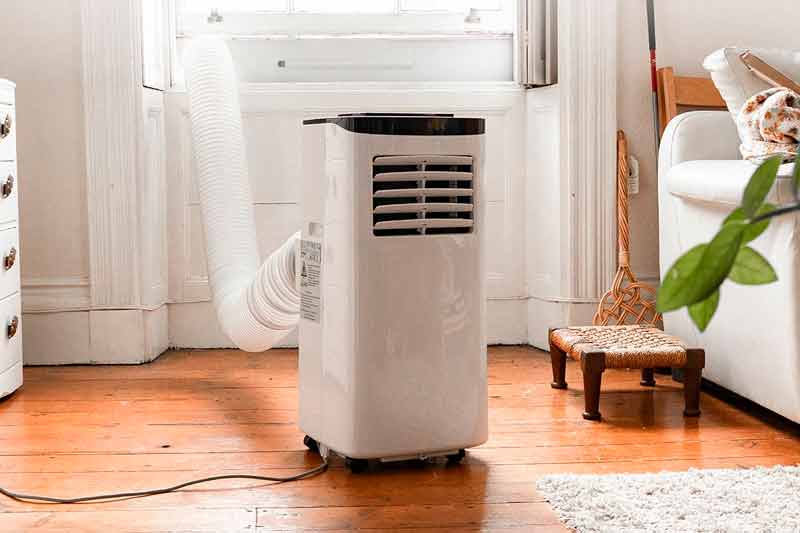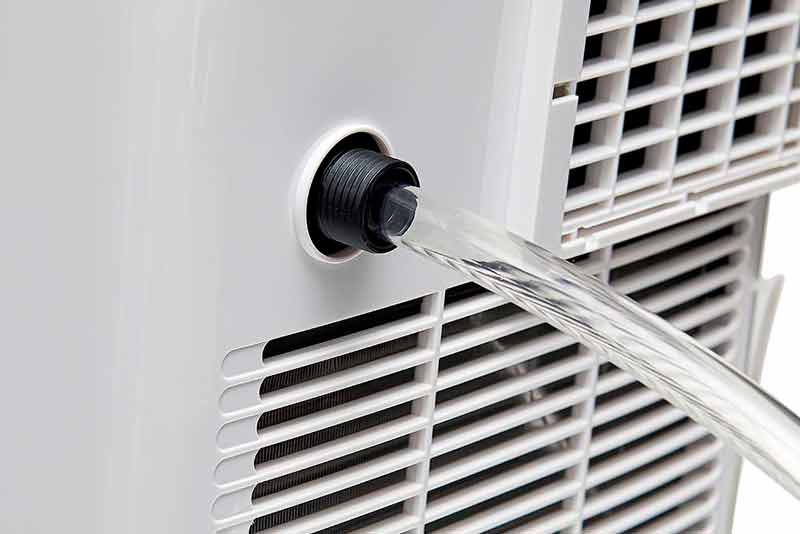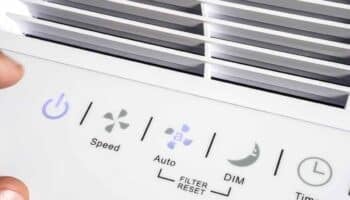You know that ACs create condensation. So why is your portable air conditioner not producing water?
While that may have you shaking your head in confusion, there are some valid reasons for a lack of water.
Your portable air conditioner may not produce water due to low humidity, improper installation, it’s too big, you have a faulty condensate pump, there’s something wrong with your drain system, and more. Additionally, it may simply be the design of your AC, as some are self-evaporating.
Keep reading, and we’ll dig deeper into each of those issues.
What You’ll Need
You may not need anything, but if you do there’s a good chance you already have them.
- Spray bottle with warm water and dish soap
- Garden hose (optional)
- Soft cloth or brush
- New drain hose
Why your Portable AC Isn’t Producing Water

Let’s walk through those one at a time, and I’ll provide you with a fix for each.
#1 You Have a Self-Evaporating AC
While it’s true that all air conditioners create condensate as they cool your air, newer, self-evaporating technology dispenses with collected moisture automatically, saving you the hassle of emptying reservoirs or tripping over a hose that leads to your floor drain.
Some models disperse moisture through a single exhaust hose, while others have dual exhaust hoses enabling the unit to evaporate a greater quantity of moisture. However, since in some conditions, condensation still accumulates, these models do have a water reservoir and or a drain hose.
Solution:
Either check your owner’s manual or Google your model number to find out whether or not you have a self-evaporating air conditioner. If you do, you don’t need to worry about the lack of water. Your air conditioner is doing what it’s supposed to do.
#2 Low Humidity
You probably know that a primary function of your air conditioner is to remove humidity from the air.
And if you live somewhere like Phoenix, you know there’s very little moisture in the air. It’s hot, but it’s very dry. So your air conditioner may be cooling your air, but a lack of humidity can also mean a lack of water production.
There isn’t really anything to check or fix here. It is what it is.
#3 Improper Installation
If your air conditioner isn’t installed or sealed properly, warm, outside air can enter the unit and prevent it from cooling properly. This could result in reduced condensation and a decrease in water production.
Solution:
Check your owner’s manual and make sure all of the installation steps have been properly followed.
#3 Your Air Conditioner is Too Big
If your cooling load doesn’t match the size of your air conditioner, this could present several problems. Cooling load is the area you want to cool. If that area is small in comparison to the BTUs of your air conditioner, this could lead to short cycling.
Short cycling refers to the unit frequently turning on and off, preventing the unit from operating long enough to pull sufficient moisture from the air.
Step 1
The table below is a buyer’s guide provided by Lowe’s. Use it to determine whether or not your air conditioner is too big for the area you’re using it in.
| Coverage Area | BTUs |
|---|---|
| 299 sq ft or less | 8,000 BTUs |
| 300 to 500 sq ft | 10,000 BTUs |
| 501 to 700 sq ft | 12,000 BTUs |
| 1000 and over sq ft | 13,000 BTUs |
Step 2
Other than buying a smaller air conditioner, the only thing you can do is try to expand the area of coverage. This may mean opening interior doors.
#4 Dirty Air Filters
If you’ve heard it once, you’ve heard it a million times. Practically anything that goes wrong with an air conditioner can be sourced back to a clogged or dirty air filter.
A layer of dust and debris on the filter can obstruct airflow, meaning your air conditioner isn’t getting access to as much air as it needs.
Solution:
Most portable air conditioners have permanent filters that need to be cleaned instead of replaced.
Remove the filter and clean it with warm soapy water in a spray bottle. You can also take it outside and use your garden hose or dunk it in the laundry tub.
#5 Faulty Condensate Pump
Some air conditioners have a built-in condensate pump that helps drain water, or in some cases, you may have a standalone pump. In either case, if the pump malfunctions or becomes blocked, it can prevent the water from being expelled properly.
Step 1
Visually inspect the pump, looking for damage such as cracks, leaks, or loose connections. Also, ensure that it’s securely mounted and properly aligned.
Step 2
Turn your air conditioner on and listen for any weird noises coming from the condensate pump. Faulty pumps often produce a grinding, buzzing, or rattling noise.
Step 3
Make sure the pump is still receiving power and is connected to a power source. If necessary, use a voltage meter.
#6 Clogged Drain

If the drainage system isn’t working properly, your unit may be unable to remove the condensate. Not all models have a water reservoir, some may only have a drain line or spout. If you can hear the sound of water but you aren’t seeing any drainage, do the following.
Step 1
Unplug your air conditioner.
Step 2
Look for the drain spout at the back of your air conditioner and check for any visible obstructions, such as debris or lint that may be blocking the port. Use a soft cloth or brush to remove any blockages.
Step 3
If your portable air conditioner also has a drain hose, check it for any kinks, bands, or blockages. Straighten the hose if necessary and ensure that it’s properly connected to both the air conditioner and the drain point. If the hose is damaged, replace it.
If you want to get any replacement part – or see how much one would cost – click to enter your model number in the search bar below. Our partners at AppliancePartsPros stock almost every part with free guides on how to install them.

#7 Faulty Components
Finally, if some of the internal components, such as the compressor or refrigerant line are damaged or malfunctioning, this can affect not only the cooling process but water production as well.
Solution:
If you have issues with either of these parts, you’ll likely require the assistance of a technician.
Conclusion
Since many new air conditioners are self-evaporating, there’s a good chance there’s absolutely nothing wrong with your air conditioner. It’s not producing water because it’s not supposed to.
However, if you have a different type of portable AC, there are several reasons why it might have stopped generating water.
To recap:
- Low humidity
- Improper installation
- Your air conditioner is too big
- Dirty air filters
- Faulty condensate pump
- Clogged drain
- Faulty components
Hopefully, you were able to check each of these and determine which applies to you.
While you’re here, why not check out our related posts below? Perhaps we can help you with something else.







